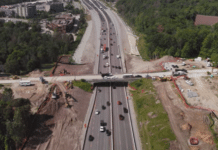Defining the supervisor’s role – and the special challenges in proving competency
By Bruce Bolduc
Special to Ontario Construction Report
This fall the Ministry of Labour has focused one of their blitzes on “supervisor competency.” Perhaps rightfully so.
Who is a supervisor and what are his or her responsibilities?
Under the Occupational Health and Safety Act (OHSA) and regulations, a supervisor is someone who has care and control of a worker. This could mean that the foreman, lead hand . . . even the shop steward could be considered a supervisor depending on the circumstances.
What does this mean? It means that many people are acting in a supervisory capacity without knowledge of the possible consequences.
Supervisors have many responsibilities under the OHSA. They are the eyes and ears of the employer at the workplace. As such supervisors may be held accountable for the actions or lack of actions by their employers.
First of all let’s look at how we become a supervisor.
In a unionized environment there is a clearly defined protocol as to what a person must accomplish to rise within the ranks.
In a non-union environment, it’s not as clear cut. A person may be promoted over the years by demonstrating to their employer a skill in managing a job or tasks. They may be a supervisor because they have demonstrated a superior knowledge at another company. Or perhaps they are simply the son or daughter of the owner, or perhaps just the last man standing.
Solid trade skills knowledge and experience does not automatically translate into good supervisory skills. Formal supervisory training is available, but not everyone classified as a “supervisor” has learned these skills.
Many of the downfalls of supervisor competency come down to some basic facts.
First is a misperception that a supervisor just has to run the job, that it’s not that much “work”. Secondly, the schedule is everything. If you have that, the rest will fall into place.
In fact, you could argue that a supervisor’s job is 50 to 90 per cent communication.
Construction supervisors must deal with many forces coming from all directions. There is the company that he or she works for and its budget, timeline and expectations.There may be a project manager above the supervisor, bringing ongoing issues and changes. The architect, building inspector, the union(s), sub-trades, utilities, Ministry of Labour, Ministry of Environment, the neighbours, permits, suppliers, storage facilities, waste disposal, security and of course….the customer. And that’s a slow day.
This list doesn’t touch on all the paperwork that’s involved from beginning to end on each project.
A good supervisor needs a thorough knowledge of structure, skill sets, trade timelines and requirements, order and process as well as interaction of all of these and of course budget considerations. Not to mention more than a passing knowledge of the OHSA and regulations.
So how does the Ministry of Labour judge a supervisor’s “competency”.
Simply put, inspectors will first assess the job site, including the company’s history with the ministry or the WSIB. Every inspector I talk with says that project housekeeping is the leading indicator on how the super is running the job. That in turn indicates competency. Secondly, inspectors like the easy route. Show me an “R.O.T”. or “Record of Training”.
Competency is defined in the OHSA in two ways, competent worker and the competent person.
For our point today is that of the competent person.
The OHSA indicates that a “Competent Person” means a person who:
a) Is qualified because of knowledge, training and experience to organize the work and its performance;
b) Is familiar with this act and the regulations that apply to the work; and
c) Has knowledge of any actual or potential danger to health or safety in the workplace.
In conclusion, the employer must by law appoint a competent supervisor. If you are a supervisor, you must know the Act and various regulations as they apply to your workplace, and enforce them. Taking no action is condoning the actions that are occurring.
Ask yourself these simple questions;
- Do you ensure that all workers, use or wear the proper personal protective equipment both required by OHSA and by the employer? Have you documented this? Where?
- Do you remind workers about workplace hazards? Have you documented this? Where?
- Do you plan for the work to be as safe as possible, or do you encourage short cuts (by actions or inaction)?
- Do you communicate with the joint health and safety committee or safety rep regularly? Have you documented this?
- Am you familiar with the Internal Responsibility System?
- Do you have an emergency response plan? Have you documented this plan, and have you made sure everyone knows it?
- Have you made use of the right (competent) people to assist in accomplishing these documentation requirements?
- Can you go home at night knowing that everyone at work, has done everything reasonable in the circumstances to ensure a safe work place?
In case you missed it: Document, document, document! Your log may be your only defence in case somebody ignores everything you did.
This is a very high overview of being a supervisor and is not intended as an all encompassing document. Hopefully it gave you something to think about.
Bruce Bolduc CHSC, CRSP, P.GSC is a consultant and owner with Construction Workplace Safety Training Inc. See www.buildwithsafety.com or phone (705) 812-1656.




